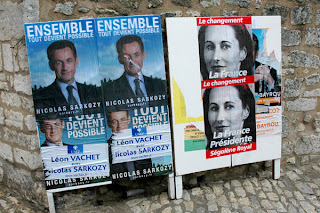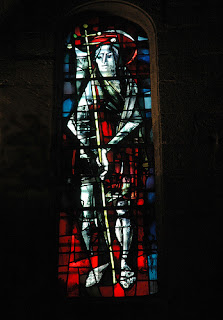With our trip now completed, here are a few random observations on our experience in Provence and the French Riviera.
--There seem to be many more chiens (dogs) in France than chats (cats). People bring their dogs with them everywhere, including to restaurants. We did have a “shop cat” in our hotel at Avignon; it often slept on one of the sofas across from the registration desk. It was jet-black and so was the sofa, so it was always a good idea to look before you sat down.
--People wondered if we’d get to see Provence’s famous lavender fields in bloom. As it turns out, that doesn’t happen until late June. We did see some pretty impressive fields of poppies, though.
--Our trip director from Alumni Holidays, Fred Burke, was endlessly helpful to the travelers, and a fascinating guy to boot. Born in the U.S., he has worked all over the world, and now lives in Normandy with his French-born wife. He taught himself French and is now fluent in it. He also worked on the production of the movie Winged Migration, helping to raise and train some of the birds used in the film.
--A good expression to know in France is a simple one: “C’est bon,” meaning “It’s good.” Whenever we’d re-board the bus after a photo stop, for example, Fred would count heads and then call up to the driver, “C’est bon!” -- and off we’d go.
--For those of us who remember almost none of their high school French, another useful expression is “Où est…” -- pronounced “oo-ay” -- which means “Where is…?” We also quickly caught onto the fact that a “boulangerie” is a bakery, of which there are many in France. And if you need a beer, that’s “bière.”
--The phrase I said more than any other on the trip was, “Un verre de Coca Light avec des glaçons, s’il vous plait”: A glass of Coke Light with ice cubes, please.
--Fred would post the meal menus for the day on an easel near the hotel’s front desk, and a hobby for many of us was trying to decipher the French so we could figure out what’s for dinner. The main course one night, for example, was “joue de loup et son tajine de legumes au miel.” Anybody? Anybody?
--We ate many of the foods you might expect on a trip to France: Croissants were omnipresent at the breakfast buffet, and French bread was served at every single meal. Main courses featured fish, poultry, or occasionally lamb or veal. Wine was served not only at dinner, but at lunch too.
--We had French fries once.
--Several of the travelers had a hankering for bouillabaisse, which apparently has its origins in Marseille. As for me, I kept waiting for the crème brûlée. Alas, no bouillabaisse or crème brûlée ever materialized. Next trip!
--The French presidential election was a common topic of conversation on the tour bus. Fred told us that if you ask his daughter, who is 3, who won the election, she will declare, “Nicolas Sarkozy is the President of the Republic!”
--A piece of trivia: Pablo Picasso often gambled at the casino at Monte Carlo.
--Everyone got home safe and sound, albeit a little tired from our 12 days of adventures. We all have pictures to show off, stories to tell, and dreams of going back there someday. C’est bon.
 In France, lots of people bring their dog to lunch or dinner with them.
In France, lots of people bring their dog to lunch or dinner with them.
 With the French presidential election taking place on May 6, political signs for the two candidates could be found everywhere.
With the French presidential election taking place on May 6, political signs for the two candidates could be found everywhere.
 Fred Burke, our travel director from Alumni Holidays, handled all of the trip logistics and was on top of every detail.
Fred Burke, our travel director from Alumni Holidays, handled all of the trip logistics and was on top of every detail.











































 The church in the hilltop village of Les-Baux, the Igles St-Vincent, has modernistic stained-glass windows—a gift of the famous Grimaldi family of nearby Monaco.
The church in the hilltop village of Les-Baux, the Igles St-Vincent, has modernistic stained-glass windows—a gift of the famous Grimaldi family of nearby Monaco.




